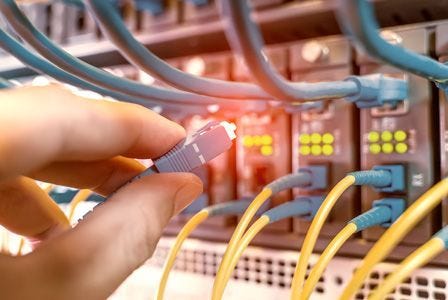

What is a patch panel? How do patch panels work?
To make the most of the lightning-fast Internet currently available, wired networks will often enable you to reach speeds that are much higher than wireless networks. A patch panel provides a central connectivity point within a wired network that is easy to access for moving, adding and changing (MACs).
What is a Patch Panel?
A patch panel within a local area network (LAN), usually 24 ports, is used to connect and control the incoming and outgoing LAN cables. A patch panel is a common way to keep a large number of cables in order. They provide user connectivity to the network hardware that may be located in a data centre or computer/server room.
Patch panels are generally mounted within industry-standard 19-inch or 23-inch racks. The typical design of a patch panel includes LAN cables terminated on the rear and RJ45 ports on the front used for patching devices to active equipment. Cables that run throughout an entire campus or building are terminated in a central location, providing flexible connectivity. Apart from being utilized in Enterprise LANs, panels are also used in the traditional broadcast, voice and television fields.
How do patch panels work?
Patch panel ports can be configured to take twisted-pair, fibre optic, or coaxial cables within the data centre or computer room. Within an Enterprise network, patch panels function as static switchboards whereby users are connected or disconnected from active equipment, such as servers, routers, switches etc. In buildings that require satellite or cable television connections with central control, coax patch panels can be utilized to feed television sets to large areas of the building.
A patch panel utilizes a patch cord, which is a kind of jumper cable to establish each interconnection between a device and the Ethernet switches, router, or server. Organizations such as small businesses or schools often install patch panels inside the wiring closets. These are usually tiny rooms where networking and electrical connectivity are safely housed.
Summing Up
Patch panels are generally mounted into racks within a data centre or computer room, either above or below network switches or other active equipment. They typically take up 1RU-2RU of space. 1RU equals 44.45mm in vertical space within the rack. Connecting the port of the patch panel to a port of the active equipment creates permanent connections, which will not be affected by the process of moving, adding or changing (MACs) other devices.
Recent Articles

Test Network Cabling & Patch Cords FAST with the New DATATESTER by CABAC
Testing LAN cables is quick and easy when you’ve got the new CABAC DATATESTER on hand. This budget LAN cable tester is perfect for contractors who need to test data and coaxial cable for correct termination.
View Products
Exploring the Advantages of Thin Patch Leads
For Australian data installers, selecting the right network components is critical to achieving the performance and reliability that your customers expect. Among these components, the humble patch lead plays a crucial role in interconnecting various devices.
View Products
FOBOT Buying Guide
In this informative article, we will provide a basic buying guide for FOBOTs or “Fibre Optic Break Out Trays” so that you can choose the right product for your specific needs.
View Products
What is a FOBOT?
In this article, we will explain what a FOBOT is and where they are used. We will also describe how a FOBOT works and the important role this component plays in managing and distributing optical fibres efficiently. So, if you're looking to learn all about FOBOTs, make sure to read this article...
View Products
What is the difference between OS1 and OS2 Singlemode Optical Fibre?
This technical article delves into the differences between OS1 and OS2 Singlemode fibre optics, including their core characteristics, performance specifications, and ideal applications.
View Products






